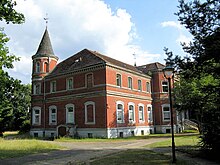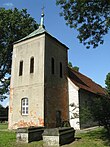Ferber (Mecklenburg noble family)
Ferber is a Mecklenburg noble family .
The family is neither with the Danzig family Ferber nor with the Saxon barons v. Ferber is related , but to be distinguished from these.
history
The stock series of sex begins with from Hameln originating and Rostock late Duke of Mecklenburg District Administrator Dr. jur. Johann Levin Ferber (* 1616; † 1680), landlord of Kassebohm (today Rostock-Kassebohm) and Varchentin . His sons Dr. jur. Carl Friedrich Ferber (* 1653; † 1714), court and regional court advocate, and Gustav Ferber (* 1657; † 1718) were raised to knightly imperial nobility in Vienna on July 3, 1704 (so-called letter nobility ). On April 8, 1706 the Mecklenburg recognition took place.
In 1798 Friedrich August von Ferber received the Mecklenburg indigenous population on Melz . In 1833 eight sons of the family from the offices of Amt Criwitz, Güstrow, Mecklenburg, Stavenhagen and Wredenhagen belonged to the extended knighthood of Mecklenburg-Schwerin.
Historical property
In 1693, the privy councilor Johann Levin von Ferber acquired the Kruseschen share in Bredenfelde , which Duke Friedrich Wilhelm declared to be a kunkellehen . So the inheritance of the property was also possible in the female line. After the death of the court master Johann Friedrich von Ferber on Varchentin , Bredenfelde and Kraase in 1752, his sister, a widowed von Klinggräff , received these goods in the division of the estate.
From 1732 the von Ferber family owned Priborn , Melz and Karbow . Ernst von Ferber and his wife Vally von Bornstedt built the two-storey manor house in Priborn between 1870 and 1880. In 1880 the goods complex was combined in a Fideikommiß , but Karbow was sold to the Mecklenburgische Siedlungsgesellschaft in 1928/29. The last owner of the Priborn and Melz estates with an area of 1,200 hectares was Horst von Ferber (* 1882; † after 1945) until the land reform in 1945. The family crypt of the family can still be found in the village church of Melz .
The Ferber also owned the estates Breesen, Bussewitz, part of the camps, Klein Helle, Kaltenbogen, Kritzow, Klein Lunow, Nutschow, Poppendorf, Sarnow, Schönberg, Solzow, Striggow, Vorwerk, Wattmanshagen and Wortum in Mecklenburg.
The family was also wealthy in Swedish Pomerania , especially in the Grimmen district . There the goods Thurow, Strehlow, Voigtsdorf and Zarrenthin were part of the family estates. The Turow moated castle came into the family through the marriage of Johann Gustav von Ferber to Ulrike von Königsheim in 1719; he paid off his sisters-in-law and thus acquired not only the Turow estate but also the Strelow, Voigtsdorf and Oelsdorf estates. The estate remained in the family's possession for over 200 years. In 1927, childless Alexandra von Ferber sold parts of the debt-laden property to the Pomeranian settlement community, but kept the moated castle, which she bequeathed to the preacher Heinrich Neumann when she died in 1939, who later left it to the church.
coat of arms
The family coat of arms (1704) shows in red on a green hill a golden detonating rod between two (silver) clover leaves growing on outwardly turned green stems , each covered by a golden (silver) star in the two upper corners . On the helmet with red and gold covers a gold-horned ibex .
literature
- Julius Theodor Bagmihl : Pommersches Wappenbuch . Volume III, Stettin 1847, p. 161, Tfl. 50
- Karl von Ferber: family tables of the family v. Ferber in Mecklenburg and New Western Pomerania. Schwerin 1908
- Genealogisches Handbuch des Adels, Adelslexikon Volume III, Volume 61 of the complete series, pp. 247-248, CA Starke Verlag , Limburg (Lahn) 1975 ISSN 0435-2408
- Gothaisches Genealogisches Taschenbuch der Nobligen Häuser , B, Justus Perthes , Gotha 1911 (family and older genealogy), 1912–1941 (continuations)
- Ernst Heinrich Kneschke : New general German nobility lexicon . Volume III, Leipzig 1861, pp. 229-230
- Leopold von Ledebur : Nobility Lexicon of the Prussian Monarchy . Volume I, Berlin 1855, p. 218 ; Volume III, 1858, p. 251
- Gustav von Lehsten: The nobility of Mecklenburg since the constitutional hereditary comparisons (1755). Rostock 1864, pp. 68-69
- Theodor Pyl (Hrsg.): Pomeranian genealogies according to documented sources and the collections of A. Balthasar , JA Dinnies and C. Gesterding . Volume 2, Issue 1, Greifswald 1868, pp. 72-77



